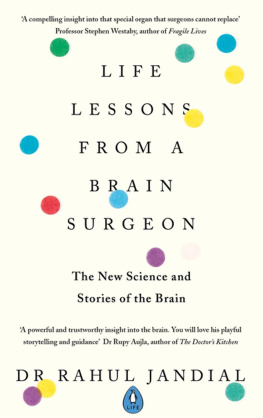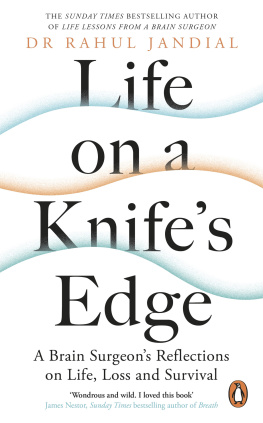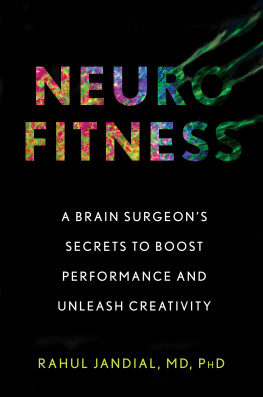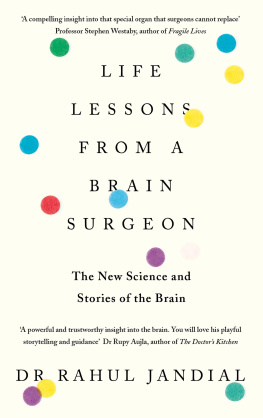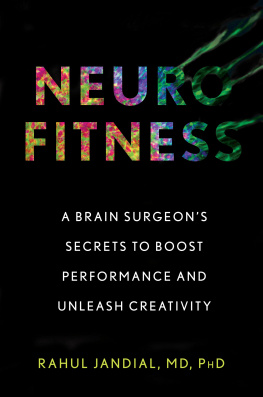
Rahul Jandial, MD, P H D
LIFE LESSONS FROM A BRAIN SURGEON
The New Science and Stories of the Brain

Contents
About the Author
Rahul Jandial, MD, PhDis an American dual-trained neurosurgeon and scientist at City of Hope, a research centre, hospital and postgraduate training faculty in Los Angeles. When he isnt performing surgery he is leading a team of scientists in Jandial Laboratory, named after him and known for its cutting-edge approach to brain surgery and neuroscience. In addition to being a world-class surgeon and scientist, Dr Jandial is the author of ten academic books and over 100 papers, but Life Lessons from a Brain Surgeonis his first book for a general audience. He has appeared on Todayand Nightline, both of which are American news shows, and also on programmes on the American television channels Discovery, and National Geographic, amongst others. He has also written first-person columns for VICE,a magazine and website focused on the arts, culture and current news topics.
To the love of my life Danielle

Prologue
It felt absolutely medieval. This wasnt a maneuver that would work with gradual pressure, like the tightening of a vise. It needed a quick, crushing force. So I used a head holder, with one-inch-long steel pins, to secure the skull to the operating table. That way, if my patient started to move, her head would remain still, and I wouldnt accidentally kill her.
The three metal pins would need to bite down into her skull after puncturing her scalp: one pin in her forehead, two in the back, all connected to a C-shaped clamp. While my assistant held up the patients head from the neck, I explosively captured her cranium inside the steel device. The jarring noise from the metal gears made the students, nurses, and doctors standing behind me in the operating room fall silent. The first of several hundred steps that needed to go smoothly, quickly, and perfectly had just been completed.
So began my first time opening the skull of a living human being. I was a third-year resident at the University of California, San Diego, Department of Neurosurgery. My patient was in her midthirties and had come to the hospitals emergency room two days before, reporting a peculiar weakness and awkwardness in her left arm and hand. An MRI had revealed a bright white abnormality on her brain a tumor the size of a peach.
Many times before, I had stood beside senior neurosurgeons, assisting, observing, and learning. But this was my first time going solo.
Its an odd thing brain surgery. Theres fear, of course, but also awe that youre literally inside somebodys head, which elicits intensity as well as excitement. I dont want to sound indelicate, but for me its a thrill. Some people like skiing, or mountain climbing, or playing poker. I like operating on peoples brains.
The risk is that I will nick a vein and a part of the brain will die. Or I will go in at the wrong spot and wont be able to reach most of the tumor. Or everything will seem to go perfectly during the surgery, but the patient will wake up unable to speak for the rest of their life.
The hope and why I do it is that this woman, who just got married three months ago and has much of her life ahead of her, will have her strength and fine control of her left hand restored as good as new.
Despite having abnormal tissue in her brain, this patient was pretty lucky because the mass wasnt malignant. Her life was not at risk from the tumor, just from me. But as long as the tumor remained and continued to grow, her muscle weakness could worsen and spread. It was nestled in the motor strip of the right parietal lobe a half-inch-wide, seven-inch-long ribbon of brain tissue that sends movement signal to the left side of the body. This particular type of tumor is called a meningioma because it grows from the lining ( meninges) of the brain. Since the skull cant stretch, the tumor knuckles into the brain, deforming it, without actually penetrating the tissue. The pressure, however, interferes with the electrical signals, leading to weakness.
After drilling off a circular piece of bone near the top of her skull what brain surgeons call turning the flap I gently sliced with a number-11 scalpel into the dura the thin, cloth-like membrane that protects the brain.
Next page
